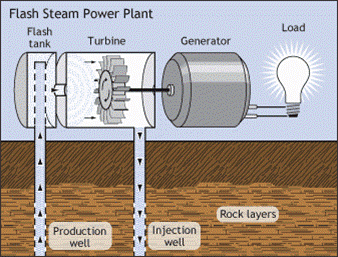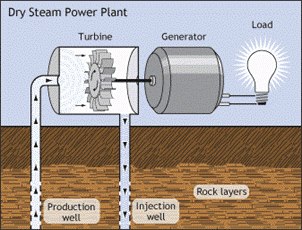What is Geothermal Energy
Heat is a form of energy, while geothermal energy is heat stored in the earth that have both water (hydro) and heat (thermal) and can be utilized by humans if released to the surface. The utilization of geothermal energy can be done starting from drilling process into the earth and then piping steam or hot water to the surface. Although geothermal energy is stored in very large quantities, only a small portion can be utilized by humans [3].
Indonesia's location between volcanoes, tectonic plate meetings, and the equator makes it a country with enormous geothermal renewable energy potential. By utilizing geothermal energy, many advantages will be obtained compared to using fossil fuels, geothermal energy can be used as a renewable alternative energy whose presence is always constant and does not depend on the weather and season [1].
Geothermal is one example of renewable energy that can be utilized to generate electricity while minimizing the impact on the environment [2]
Type of Geothermal system
Conversion of geothermal energy into electrical energy is not a cheap or simple process so there is a real need to use the available energy efficiently. Currently, there are three types of geothermal power plants [4]:
- Flash Steam Power Plant
Flash steam plants differ from dry steam because they pump hot water, rather than steam, directly to the surface. These flash steam plants pump hot water at a high pressure from below the earth into a “flash tank” on the surface.
The flash tank is at a much lower temperature, causing the fluid to quickly “flash” into steam. The steam produced powers the turbines. The steam is cooled and condenses into water, where it is pumped back into the ground through the injection well [5].

Source: https://www.energy.gov/eere/geothermal/electricity-generation
- Dry Steam
Dry steam plants are the most common types of geothermal power plants, but not common use in Indonesia due to the steam form is not possible to direct use.
They work by piping hot steam from underground reservoirs directly into turbines from geothermal reservoirs, which power the generators to provide electricity.
After powering the turbines, the steam condenses into water and is pumping back into the earth via the injection well [5].

Source: https://www.energy.gov/eere/geothermal/electricity-generation
- Binary Organic Rankine Cycle (ORC)
In a binary cycle power plant, the main difference is that the water or steam from underground never comes into direct contact with the turbine. Instead, water from the geothermal reservoir is pumped through a heat exchanger where it heats a second fluid—such as isobutene or pentane (which boils at a lower temperature than water).

Source: https://www.energy.gov/eere/geothermal/electricity-generation
This second fluid is heated to steam, which drives a turbine that drives a generator. The hot water from the earth is recycled back into the earth through an injection well, and the second fluid is recycled through the turbine and back to the heat exchanger where it can be used again [5].
The Binary ORC also applied in some geothermal power plant in Indonesia.
Geothermal potential in Indonesia
Geothermal energy potential in Indonesia is very large since it was in the ring of fire area, Indonesia holds 40% of the world's geothermal reserves, reaching 23.7 giga watt (GW) or the second largest in the world. This potential is spread throughout Indonesia, especially in western regions such as Sumatra, Java, and Bali [7].
| Regions/ Island | Capacity (MW) |
| Sumatera | 9.517 |
| Java | 8.050 |
| Bali | 335 |
| Nusa Tenggara | 1.399 |
| Borneo | 175 |
| Sulawesi | 3.071 |
| Maluku | 1.144 |
| West Papua | 75 |
Table Source : https://ebtke.esdm.go.id/lintas/id/investasi-ebtke/sektor-panas-bumi/potensi
Source :
- Jurnal Energi Baru Dan Terbarukan, 1(3), 111–123. (https://doi.org/10.14710/jebt.2020.10032)
- Mukhamad, F., Umam, F., Muhammad, D. W., Adityatama, D. P., & Purba, A. (2018). Tantangan Pengembangan Energi Panas Bumi Dalam Perannya terhadap Ketahanan Energi di Indonesia
- Natacha C. Marzolf. EMPRENDIMIENTO DE LA ENERGÍA GEOTÉRMICA EN COLOMBIA. 2007
- Ronald Di Pippo. Geothermal Power Plants Third Edition. 2012. (https://books.google.co.id/books?hl=id&lr=&id=U9TRQp_empgC&oi=fnd&pg=PP1&ots=HpAO4ep5BU&sig=7l-efi-2O5vGDr9JQ-LCs0_cEng&redir_esc=y#v=onepage&q&f=false)
- https://www.saveonenergy.com/green-energy/geothermal-energy/
- https://www.jgc.com/en/news/2023/20230803.html
- https://ebtke.esdm.go.id/lintas/id/investasi-ebtke/sektor-panas-bumi/potensi
- https://www.energy.gov/eere/geothermal/electricity-generation
This article is written by :
Annisa Dewi Rianti
Sales & Marketing




.webp)

.webp)